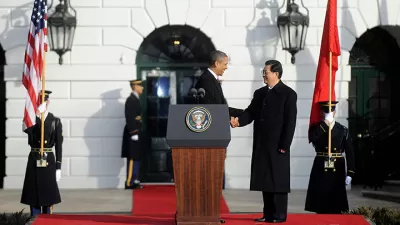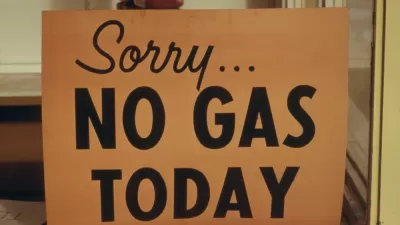The Conference of Parties (COP21) held during the last two weeks in Paris establishes ambitious climate change emission reduction targets. This will be a challenge and opportunity for planners. Here are some highlights.

We live in amazing times! The Paris COP21 Conference achieved important and challenging goals: through it almost all the countries in the world developed strategies (called Intended Nationally Determined Contributions, or INDCs) that outline their commitments on climate change mitigation and adaptation. Many of these have significant implications for transportation and land use planning.
A good source of information on these implications is the Sustainable Low Carbon Transortation (SLoCaT) Partnership, an international coalition of major organizations (including development banks, government agencies and advocacy organizations), which took a leadership role in providing information resources, and organizing the "We Are Transport" and the 80 Days campaigns which shared this information through various networks. This helped convince many experts and decision-makers that transport and land use policy reforms can help achieve emission reduction targets.
- "Creating jobs and sustaining growth as well as eradicating poverty in a carbon-constrained world demand a restructuring of energy and transport systems." (Seretse Khama Ian Khama, President of Botswana)
- "The best economic and scientific data will serve as a basis for strategic options, which will include carbon pricing, support for energy efficiency initiatives, clean electricity and transport technology, and sustainable building and infrastructure." (Justin P. J. Trudeau, Prime Minister of Canada)
- "China will, on the basis of technological and institutional innovation, adopt new policy measures to improve the industrial mix, build low-carbon energy systems, develop green building and low-carbon transportation, and build a nation-wide carbon emission trading market so as to foster a new pattern of modernization featuring harmony between man and nature." (Xi Jinping President of the People’s Republic of China)
- "My government has announced projects aimed at speeding up the decarbonizing of transport, fisheries and agriculture – in cooperation with the industries concerned, which we think is crucial for success." (Sigmundur Davíd Gunnlaugsson, Prime Minister of Iceland)
- "My office has launched an initiative, to reduce global dependence on crude oil, especially in transportation." (Benjamin Netanyahu, Prime Minister of Israel)
- "To illustrate, there are technologies to produce, store and transport hydrogen towards realizing CO2-free societies, and a next-generation battery to enable an electric car to run five times longer than the current level." (Shinzo Abe, Prime Minister of Japan)
- "We have taken the first steps in switching Jordan’s public sector fleet to eco-friendly electrical vehicles." (Abdullah II Ibn Al Hussein, The King of Jordan)
- "Some of the sector-wide voluntary domestic measures and actions to address climate change include low carbon and efficient transportation systems." (Uhuru Kenyatta, President of Kenya)
- "Korea's best known island, Jeju will transition into a carbon free island by replacing its entire fleet of cars with electric vehicles and meeting 100% of its energy needs through renewable energy sources." (Park Geun-hye, President, Republic of Korea)
- "In the next few years, Panama will culminate the building and integrate the urban transport system, which will have three metro lines, a bus network to provide public transport system which is modern, efficient and environmental friendly." (Juan Carlos Varela, President of Panama)
- "In Paraguay we are renewing our public transport fleet, investing new technologies that are multi-modal and efficient for reducing the use of fossil fuels." (Horacio Manuel Cartes, President of Paraguay)
- "Several mitigation initiatives including promotion of affordable renewable technologies, measures towards energy efficiency, implementation of a mass transport system, and expansion of hydroelectrical potential are already part of our development strategies." (Muhammad Nawaz Sharif, Prime Minister of Pakistan)
- "We are working on all fronts to achieve this target by using less fossil fuels and more renewable energy, such as promoting the use of hybrid and electric cars, switching from road to rail transport." (Prayut Chan-O-Cha, Prime Minister of Thailand)
This is a huge achievement. Well done diplomats! But now that their job is done, our work begins. It is also a huge challenge and a huge opportunity. As discussed in my recent column, "We Are Transport! We Have Solutions!" many climate change emission reduction strategies can help achieve other planning goals, ranging from traffic and parking congestion reductions, to improving affordability. Now that many local, state/provincial, and federal jurisdictions are establishing emission reduction objectives, we have another opportunity to build support for these win-win emission reduction strategies.
Critics often assume that emission reductions are economically harmful and unfair to disadvantaged people, but many transport and land use policy reforms actually increase efficiency and improve affordable mobility and housing options, and so help achieve economic and social as well as environmental goals. The New Climate Economy's Better Growth, Better Climate and my study, Analysis of Public Policies That Unintentionally Encourage and Subsidize Urban Sprawl, describe specific policies that help achieve these multiple goals. Many of these can be implemented at the local or regional level.
During the COP21 closing session, the South Africa representative noted that we must turn "the finish line that is Paris into a new starting line for the ongoing process that leads to Marrakech and beyond." She then quoted her country's great leader:
"I have walked that long road to freedom… I have not faltered, [though] I have made many missteps along the way. I have taken a moment here to rest, to steal a view of the glorious vista that surrounds me…but I can only rest for a moment, for with freedom comes responsibilities and I dare not linger, because my long walk is not ended." (Nelson Mandela)
This is, overall, a good news story for planners and the people we serve. We can create truly sustainable communities that balance economic, social and environmental goals. Our challenge is to communicate to sometimes skeptical stakeholders that they can benefit overall from innovative solutions. Who will identify and implement these solutions? We will, planners!

Depopulation Patterns Get Weird
A recent ranking of “declining” cities heavily features some of the most expensive cities in the country — including New York City and a half-dozen in the San Francisco Bay Area.

California Exodus: Population Drops Below 39 Million
Never mind the 40 million that demographers predicted the Golden State would reach by 2018. The state's population dipped below 39 million to 38.965 million last July, according to Census data released in March, the lowest since 2015.

Chicago to Turn High-Rise Offices into Housing
Four commercial buildings in the Chicago Loop have been approved for redevelopment into housing in a bid to revitalize the city’s downtown post-pandemic.

New Park Opens in the Santa Clarita Valley
The City of Santa Clarita just celebrated the grand opening of its 38th park, the 10.5-acre Skyline Ranch Park.

U.S. Supreme Court: California's Impact Fees May Violate Takings Clause
A California property owner took El Dorado County to state court after paying a traffic impact fee he felt was exorbitant. He lost in trial court, appellate court, and the California Supreme Court denied review. Then the U.S. Supreme Court acted.

How Urban Form Impacts Housing Affordability
The way we design cities affects housing costs differently than you might think.
City of Costa Mesa
Licking County
Barrett Planning Group LLC
HUD's Office of Policy Development and Research
Mpact Transit + Community
HUD's Office of Policy Development and Research
City of Universal City TX
ULI Northwest Arkansas
Town of Zionsville
Write for Planetizen
Urban Design for Planners 1: Software Tools
This six-course series explores essential urban design concepts using open source software and equips planners with the tools they need to participate fully in the urban design process.
Planning for Universal Design
Learn the tools for implementing Universal Design in planning regulations.






















